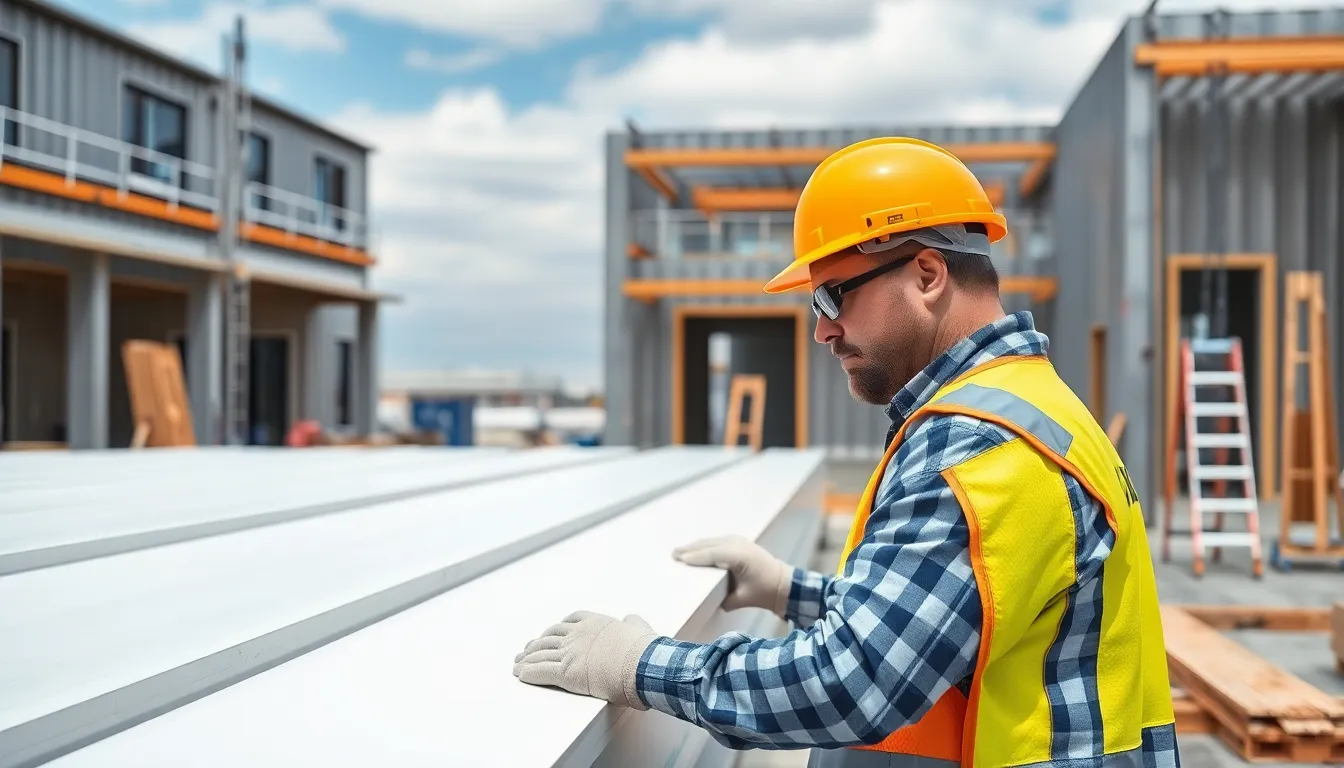Table of Contents
ToggleIn a world where time is money and energy efficiency is king, efficient building assemblies are the unsung heroes of construction. Imagine a building that not only stands tall but also saves the planet one brick at a time. It’s like having your cake and eating it too—except this cake is made of eco-friendly materials and keeps your utility bills low.
Building assemblies have evolved from simple structures to sophisticated systems that maximize performance and minimize waste. They’re the secret sauce behind modern architecture, blending sustainability with style. So, if you’re ready to ditch the old ways and embrace the future of construction, buckle up. Efficient building assemblies aren’t just a trend; they’re the blueprint for a smarter, greener tomorrow.
Overview of Efficient Building Assemblies
Efficient building assemblies constitute advanced construction systems that enhance overall performance. These assemblies integrate materials and techniques designed for energy efficiency, sustainability, and reduced environmental impact. Various components, such as insulated panels, modular systems, and pre-fabricated elements, increase durability and decrease waste during construction.
The use of insulated panels minimizes energy loss in residential and commercial buildings. This technology significantly reduces heating and cooling costs, promoting long-term savings. Modular systems introduce versatility in design while speeding up the overall construction process. The ability to assemble parts off-site streamlines logistics and limits on-site disruptions.
Innovative pre-fabricated elements offer numerous benefits, including precise manufacturing and reduced labor costs. These elements commonly include wall systems, roof trusses, and flooring components. By utilizing these systems, architects and builders can ensure more consistent quality control, leading to improved building performance.
Energy-efficient building assemblies often incorporate sustainable materials. Examples include recycled content in insulation and low VOC (volatile organic compound) materials in finishes. Architects can design spaces that meet or exceed energy performance standards, addressing both environmental and economic considerations.
Utilizing advanced assemblies often facilitates compliance with regulations related to energy efficiency. Building codes increasingly mandate sustainable practices, pushing the construction industry toward innovative solutions. Embracing these assemblies fosters a shift toward eco-friendly designs that align with modern sustainability goals.
Education and awareness about efficient building assemblies play vital roles in promoting their use. Builders, architects, and developers who understand the long-term benefits are more likely to adopt these practices. As demand for sustainable buildings increases, efficient building assemblies stand at the forefront of modern construction methodologies.
Benefits of Efficient Building Assemblies
Efficient building assemblies play a vital role in modern construction, offering numerous advantages. Among these benefits, energy efficiency and cost savings stand out.
Energy Efficiency
Energy efficiency remains a key advantage of efficient building assemblies. Insulated panels significantly reduce energy loss during heating and cooling. As a result, buildings maintain comfortable temperatures with less energy consumption. Advanced construction methods often integrate renewable materials, ensuring sustainable practices. Building assemblies designed for performance meet or exceed energy standards, contributing to lower carbon footprints. Compliance with energy efficiency regulations becomes smoother, guiding developers toward innovative solutions. By prioritizing energy efficiency, architects can create spaces that are not only functional but also eco-friendly.
Cost Savings
Cost savings materialize in several areas through the use of efficient building assemblies. Reduced energy consumption leads to lower heating and cooling expenses over time. In addition, the implementation of modular systems accelerates construction timelines, minimizing labor costs. Pre-fabricated elements enhance quality control, decreasing the likelihood of costly mistakes. Builders can also benefit from less waste generated on-site, leading to significant material savings. Manufacturers and suppliers of sustainable materials often offer competitive pricing, further lowering overall project costs. Together, these efficiencies promote a more economical approach to construction, making it appealing for both investors and developers.
Types of Efficient Building Assemblies
Efficient building assemblies come in various forms, each offering its unique benefits for modern construction. Understanding these types helps builders and architects make informed decisions.
Prefabricated Systems
Prefabricated systems streamline the construction process. Components are manufactured off-site and assembled on-site, significantly reducing construction time. Quality control benefits from this method, as parts are built in a controlled environment. Labor costs decrease due to the speed of assembly. Projects often see fewer delays, resulting in quicker occupancy. Utilizing prefabricated elements enhances sustainability, as precise manufacturing minimizes waste. This approach effectively improves overall project efficiency.
Modular Construction
Modular construction revolutionizes traditional building methods. Individual sections, or modules, are constructed in a factory and then transported to the site for assembly. The design versatility of these modules allows for creative architectural solutions. Each module can include various components, such as plumbing and electrical systems, which are installed before delivery. The integration of modular systems often accelerates project timelines, leading to earlier project completion. Builders experience substantial cost savings through reduced material waste and efficient labor use. Adopting modular construction further strengthens the sustainability profile of the project.
Materials Used in Efficient Building Assemblies
Efficient building assemblies utilize a range of materials that prioritize sustainability and performance. Selecting the right materials enhances energy efficiency while reducing environmental impact.
Sustainable Options
Sustainable materials play a crucial role in efficient building assemblies. Recycled steel offers high strength while reducing overall resource consumption. Bamboo serves as a renewable alternative due to its rapid growth and low environmental footprint. Additionally, reclaimed wood adds aesthetic appeal and minimizes deforestation impact. Each of these materials aligns with green building standards, promoting a healthier indoor environment while contributing to energy-efficient designs.
Innovative Technologies
Innovative technologies are transforming the landscape of materials used in efficient building assemblies. Insulated concrete forms enhance thermal performance by minimizing energy loss, while advanced glazing systems improve natural light intake and energy efficiency. Smart materials that adapt to environmental changes are paving the way for futuristic architecture, optimizing energy use based on occupancy and weather conditions. These technologies not only increase durability but also lower maintenance costs, positioning modern assemblies at the forefront of sustainable building practices.
Case Studies of Efficient Building Assemblies
Several notable case studies highlight the impact of efficient building assemblies on construction processes and outcomes.
The Edge, located in Amsterdam, serves as a prime example. This office building incorporates insulated panels and smart building technologies, resulting in an energy-neutral design. Energy consumption decreased significantly, with operational costs reduced by 70%.
Another case is the Bullitt Center in Seattle. Recognized as one of the greenest commercial buildings, it utilizes prefabricated components that enhance construction efficiency. It features a rainwater harvesting system and solar panels, achieving a net-zero energy status.
In New York City, the Via Verde housing development showcases modular construction effectively. This project integrates sustainable materials like reclaimed wood, promoting both energy efficiency and aesthetic appeal. Residents benefit from reduced energy costs and improved living conditions, making the development a model for future urban housing.
The Crystal in London provides insight into innovative material use. This building employs advanced glazing systems that optimize natural light intake while reducing energy loss. Energy expenses drop, demonstrating how selecting appropriate materials can contribute to sustainability.
Lastly, the Bosco Verticale in Milan exemplifies the integration of green spaces. This residential tower incorporates vertical gardens, improving air quality and enhancing building insulation. Enhanced living conditions attract residents, illustrating how thoughtful design promotes community wellness.
These case studies illustrate the efficiency and sustainability of modern building assemblies. They underscore the potential for energy savings, reduced costs, and enhanced performance in diverse projects.
Conclusion
Efficient building assemblies represent a significant advancement in construction practices. By prioritizing energy efficiency and sustainability, these assemblies not only reduce operational costs but also enhance the overall quality of buildings. The integration of innovative materials and technologies ensures that modern structures meet the demands of eco-conscious consumers and developers alike.
Embracing these practices leads to a future where buildings are not only stylish and functional but also environmentally responsible. As the industry continues to evolve, the adoption of efficient building assemblies will be crucial in shaping a sustainable architectural landscape. The potential for energy savings, reduced waste, and improved living conditions makes these assemblies an essential component of modern construction.





